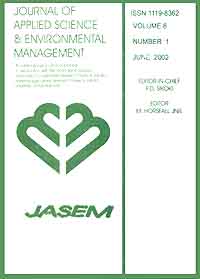
|
Journal of Applied Sciences and Environmental Management
World Bank assisted National Agricultural Research Project (NARP) - University of Port Harcourt
ISSN: 1119-8362
Vol. 16, No. 4, 2012, pp. 371-384
|
 Bioline Code: ja12063
Bioline Code: ja12063
Full paper language: English
Document type: Research Article
Document available free of charge
|
|
|
Journal of Applied Sciences and Environmental Management, Vol. 16, No. 4, 2012, pp. 371-384
| en |
Survey of Vegetation cover Changes in Forcados Area of the Niger Delta
ADOKI, AKURO
Abstract
Time Lapse Analysis revealed that Water class changed slightly across the three epochs. The water class was 312.39km2 in 1988, 312.55km2 in 1998 and 312.81km2 in 2008. Mature forest (Forest I) occupied 69.96 km2 1988 and decreased continuously to 55.59 km2 in 1998 and 41.9km2 in 2008. Forest II (Secondary forest) was 3.43km2 in 1988. This increased to 21.56km2 in 1998 and 31.41km2 in 2008. Mangrove class which covered 15.97km2 in 1988 decreased to 10.76 km2 in 1998 and 10.22km2 in 2008. Stressed Vegetation occupied 2.42km2 in 1988, and increased to 2.6 km2 in 1998 and then increased to 3.33 km2 in 2008. Urban/Industrial/Sand class increased across the epochs; from 1.94km2 in 1988 to 3.05 km2 in 1998, and 6.44km2 in 2008. The major changes are the decline in the areal coverage of mature forest by about 21% between 1988 and 1998 and 40% from 1988-2008; phenonmenal increase of secondary forest by over 800% between 1988 and 2008; decline in the areal coverage of mangrove vegetation by about 37% from 1988-2008; and progressive increase in the area occupied by stressed vegetation by 7% from 1988-1998 and 38% from 1988-2008. The results of this study underscore the need for a field study to verify the results obtained from the unsupervised image classification carried out in this work. That some major changes have taken in the biophysical environment around Forcados between 1988 and 2008 is not in doubt from this study.
|
| |
© Copyright 2012 - Journal of Applied Sciences and Environmental Management
|
|
